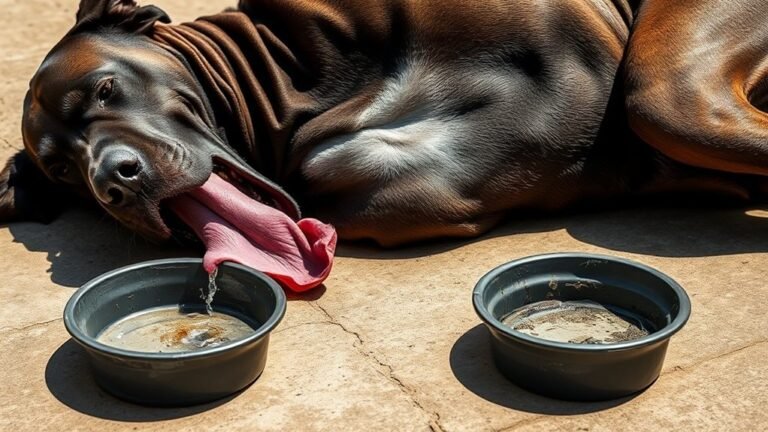Nothing Says Fall Like a Dane-Sized Pumpkin Patch Adventure

Great Dane & Pumpkin
Woof! Let me tell you about my favorite orange treat – pumpkin!
My humans discovered that pumpkin is like a superfood for us big dogs. It’s packed with fiber, beta-carotene (which sounds fancy but is good for me), and potassium. Since I weigh anywhere from 100 to 160+ pounds – yes, I’m a furry giant – my vet says I can have 2-5 tablespoons of plain, cooked pumpkin every day. They split it up between my meals, which is great because it means more food times!
The best part? This orange goodness helps keep my digestive system running smoothly. Trust me, when you’re my size, you want everything working properly! The fiber helps with both types of bathroom business – if you know what I mean. Plus, it keeps my heart strong and my immune system ready to fight off any germs that dare mess with this gentle giant.
My humans learned that pumpkin can fix tummy troubles and keep everything regular. They follow special preparation rules to make sure it’s safe for me. Below, they’ll share all their secrets about making pumpkin perfect for your four-legged family members!
Nutritional Benefits of Pumpkin for Great Danes
Woof! Let me tell you about my favorite orange treat – pumpkin! As a Great Dane, I need lots of good food to keep this giant body running.
Pumpkin is like a superfood for us big dogs. It’s packed with something called beta-carotene, which sounds fancy but helps my eyes stay sharp for spotting squirrels and keeps my immune system strong so I don’t get sick. Trust me, when you’re my size, nobody wants to deal with a sick Great Dane! Plus, pumpkin is low in calories, making it a great addition to my diet while ensuring I maintain a healthy weight.
The best part? Pumpkin has tons of fiber, which helps keep my digestive system moving smoothly. Let’s say that’s really important when you’re as big as me – my humans appreciate this benefit! It prevents me from getting all backed up, which is a common problem for us giant breeds.
Pumpkin also has potassium, which is great for my heart. Since we Great Danes sometimes have heart problems as we get older, every little bit helps. Plus, if I’ve any food allergies, pumpkin usually doesn’t bother my stomach at all.
The coolest thing is that pumpkin gives me steady energy without making my blood sugar go crazy. It’s like the perfect fuel for a gentle giant like me. Pumpkin is a source of dietary fiber, which aids in digestion and helps to regulate my bowel movements!
Safe Pumpkin Preparation Methods for Large Breed Dogs
Listen up, fellow four-legged friends! As a Great Dane who’s been around the block (and trust me, that’s a really long block when you’re this tall), I’ve learned a thing or two about getting the good orange stuff safely.
First things first – make sure your humans pick the right pumpkins! You want the regular eating kind, not those fancy decoration ones that might make your tummy feel yucky. Those decorative ones have nasty chemicals called cucurbitacins that’ll ruin your whole day.
When your human brings home a fresh pumpkin, watch them wash it really well. Then they need to scoop out all the seeds and cut off the green stem part. I know, I know – you probably want to help with this step, but trust me, let the humans handle the knife work. We’re better at the taste-testing part anyway!
The best way to cook pumpkin is by steaming or baking it without any of those spices humans love so much. No salt, no garlic, no fancy seasonings – just plain pumpkin goodness! It might sound boring, but your belly will thank you later. A balanced diet is essential for maintaining your overall health and well-being.
Once it’s cooked and cooled down, your humans should store leftovers in the cold box for about a week, or stick it in the freezer if they made too much.
And here’s a super important tip from one giant dog to another – stay away from those canned pumpkins with weird ingredients like xylitol. That stuff is seriously dangerous for us dogs!
Too much of this orange goodness can give you the runs, and nobody wants that! Remember, it’s always best to consult a veterinarian for personalized dietary advice to ensure we’re getting the right nutrients.
Recommended Pumpkin Serving Sizes for Great Dane Weight Categories
Woof! Let me tell you about pumpkin treats from a Great Dane who knows a thing or two about eating! My vet friends say we big dogs need different amounts of pumpkin based on how much we weigh – and trust me, we weigh A LOT.
If you’re like me and tip the scales at 100-130 pounds (which is tiny for a Great Dane, by the way), you get 2-3 tablespoons of this orange goodness every day. For my medium-sized buddies weighing 131-160 pounds, you lucky pups get 3-4 tablespoons daily.
And for the real giants like Thor, who weighs over 160 pounds? You get the jackpot – 4-5 tablespoons!
Here’s a pro tip from someone who’s learned the hard way: split that pumpkin between your breakfast and dinner. Your tummy will thank you later, and you won’t get that uncomfortable feeling that makes you want to lie down for three hours. Remember that a proper diet is crucial for maintaining health in Great Danes, so moderation is key.
The best part? Pretty much any pumpkin works! Canned, fresh, whatever your humans can find. Start slowly with once a day, then work up to twice daily if your stomach agrees.
Keep an eye on your bathroom habits – if things get too loose or too firm, tell your humans to adjust the amount. Trust me, they’ll figure out what you’re trying to say! Also, remember that food allergies in Great Danes can sometimes affect how well you tolerate new foods like pumpkin, so constantly monitor your reactions closely.
Digestive Health Support Through Pumpkin Supplementation
So here’s the scoop on pumpkin – it’s got two types of fiber that work like magic in my giant belly. There’s soluble fiber that dissolves and helps things move smoothly through my system, and insoluble fiber that adds bulk and keeps everything regular. Trust me, when you’re my size, “regular” is very important for everyone in the household! Eating grass can be a sign of digestive issues that pumpkin can help alleviate.
The cool part is that pumpkin has this stuff called beta-carotene and pectin that team up like superhero partners. They help my bowel movements stay just right – not too loose, not too firm, but perfectly normal. Plus, they feed all the good bacteria living in my gut, which makes me feel awesome from nose to tail.
My humans learned that us Great Danes need extraordinary amounts because we’re so big. Too little pumpkin won’t help, but too much can cause problems. The key is finding that sweet spot where my digestive system runs like a well-oiled machine. Proper nutrition is crucial for overall well-being, especially for big dogs like me.
And let me tell you, when my tummy is happy, everyone in the house is happy! No more embarrassing moments or uncomfortable feelings for this gentle giant.
Pumpkin’s Fiber Benefits
Why Pumpkin is Amazing for My Tummy (From a Great Dane Who Knows!)
My humans are always worried about my digestive system, and honestly, they should be. We big dogs have some pretty sensitive tummies.
So here’s the scoop on pumpkin and why it’s magic for dogs like me:
The Fiber Fantastic Four:
- The Sponge Effect – When my stomach decides to throw a tantrum and things get, well, too liquidy, pumpkin’s special fiber soaks up all that extra water. It’s like having a tiny superhero sponge in my belly!
- The Gentle Push – Sometimes when I eat too much (which happens more than I’d like to admit), things get stuck. Pumpkin helps everything move along nicely without making me feel gross.
- Feeding My Tiny Helpers – Apparently, I’ve millions of good bacteria living in my gut. Weird, right? But they help me feel good, and pumpkin feeds them like tiny bacterial snacks. Plus, it’s packed with nutritional benefits, which can support my overall health!
- The Goldilocks Effect – You know how Goldilocks wanted everything “just right”? That’s what pumpkin does for my bathroom breaks. Not too hard, not too soft, but juuust right.
The best part? It tastes pretty good too! My humans mix it into my food, and I look forward to dinner even more. Plus, pumpkin is an excellent source of fiber, which supports digestion and overall health!
Who knew being healthy could be this tasty?
Dosage for Great Danes
So here’s the scoop on pumpkin for us big dogs. Because I’m huge (like, seriously huge – I can rest my chin on the kitchen counter without even trying), I get to eat more pumpkin than my tiny Chihuahua neighbor. Lucky me!
My human gives me about 1-4 tablespoons of plain pumpkin every day, split up between my meals. And let me tell you, it’s pretty tasty! But here’s the important part – they started me off with just a tiny bit to make sure my giant belly could handle it. Some dogs can get upset tummies or even itchy skin from pumpkin, so it’s better to be safe than sorry.
After I proved I could handle the orange goodness, my human slowly gave me more. Now I get just the right amount – about 5-10% of all the food I eat in a day. That might sound like a lot, but remember, I eat A LOT of food. I mean, have you seen these paws?
The best part? Pumpkin helps my digestion work better, which is super important when you’re carrying around as much dog as I am.
But here’s what my human always tells other Great Dane parents – talk to your vet first! Especially if your big buddy has a sensitive stomach like my cousin Bruno.
Trust me, your vet knows best, and us Great Danes are worth the extra care!
Seasonal Pumpkin Treats and Recipes for Giant Breeds
Woof! My Guide to Awesome Fall Pumpkin Treats
Hey there, fellow four-legged friends! Tucker the Great Dane here, and let me tell you – when those leaves start falling, my tail starts wagging because pumpkin season is HERE!
Woof! Fall means pumpkin time, and this Great Dane’s tail can’t stop wagging with excitement!
Being a giant breed means I need BIG nutrition and LOTS of food. Lucky for me (and my always-hungry stomach), pumpkin is like a superfood that helps my digestion and tastes fantastic too. My humans finally figured out how to make treats that actually fill me up!
My Favorite Pumpkin Treats That Satisfy a Great Dane:
- Frozen Pumpkin Kongs – This is genius! My humans mix plain pumpkin with low-salt bone broth and freeze it overnight. It takes me forever to finish, which means I’m not begging for more food five minutes later. Plus, it keeps me busy when the mailman comes by!
- Homemade Pumpkin Chips – They slice up fresh pumpkin and dry it out for hours in some machine. These crunchy chips are way better than those tiny store treats that disappear in one bite. I have to chew them!
- Pumpkin and Sweet Potato Mash – Roasting pumpkin with sweet potatoes drives me crazy (in a good way). This orange mush is packed with vitamins and makes my coat shinier. My humans say beta-carotene is good for me, but I just know it tastes great!
- Giant-Sized Pumpkin Biscuits – Finally, treats made for dogs my size! They use coconut flour and pumpkin to make these grain-free cookies. No more feeling embarrassed about eating twenty tiny biscuits just to feel satisfied.
Trust me, when you’re 150 pounds and still growing, regular dog treats just don’t cut it. These pumpkin goodies keep my belly happy and my humans proud of my good behavior. Win-win!
Potential Risks and Precautions When Feeding Pumpkin
Woof! Listen up, my fellow gentle giants! While pumpkin is pretty amazing stuff for us Great Danes, there are a few things us big dogs need to watch out for.
First off, some of us might be allergic to pumpkin. I know, I know – it’s like being allergic to treats! The signs aren’t fun: upset tummies, itchy skin, or trouble breathing. If you’re trying pumpkin for the first time, start with just a tiny bit. Trust me, your human will be watching you like a hawk anyway.
Here’s something I learned the hard way – too much of a good thing can make you feel rotten. When I first discovered pumpkin, I may have… overindulged. Let’s just say it led to some very embarrassing moments in the backyard.
Too much pumpkin can cause the runs or even make us sick due to excessive vitamin A. My human uses fancy words like “beta-carotene,” but all I know is moderation is key!
If you’re one of those Great Danes with diabetes (yeah, we can get that too), be extra careful. Pumpkin contains natural sugars that may affect your blood sugar levels. Not cool when you’re already dealing with health stuff.
My biggest tip? Make sure your human talks to the vet before adding pumpkin to your diet, especially if you’ve got any health issues. We may be giants, but we’re sensitive giants who deserve the best care!
Final Thoughts
My humans got all excited about feeding me pumpkin after reading some fancy dog articles. Honestly, I was just happy they weren’t trying to sneak vegetables into my food bowl again. But surprise! This orange stuff is pretty awesome.
First off, pumpkin makes my tummy feel amazing. You know how sometimes us big dogs get a little gassy? Well, let’s just say my family appreciates pumpkin time because it keeps things… less explosive around the house. My digestive system runs like a well-oiled machine now.
The best part is that pumpkin has all these healthy vitamins and minerals that make my coat shinier than a freshly waxed car. I strut around the neighborhood looking like a doggy supermodel. The other dogs are jealous.
But here’s the thing – my humans learned the hard way that you can’t just dump a whole can of pumpkin in my bowl. Too much of a good thing made me feel pretty weird for a day or two. Now they measure it out carefully and mix it with my regular food. They also make sure to use plain pumpkin, not that pie filling stuff that has too much sugar.
Trust me, when you’re my size, proper pumpkin portions make all the difference in feeling fantastic and keeping everyone happy!







One Comment